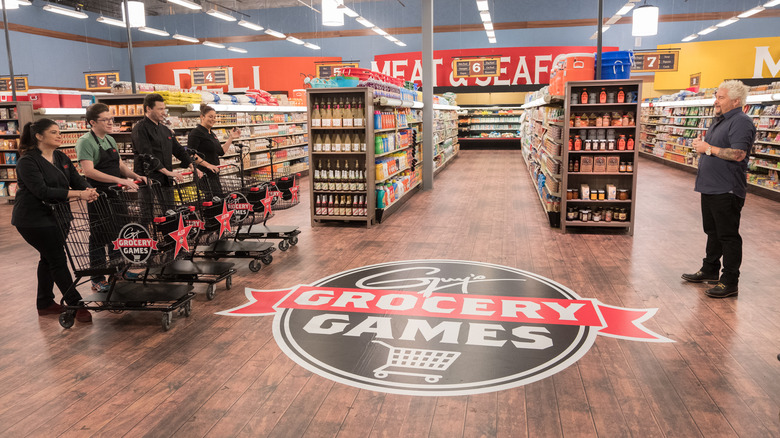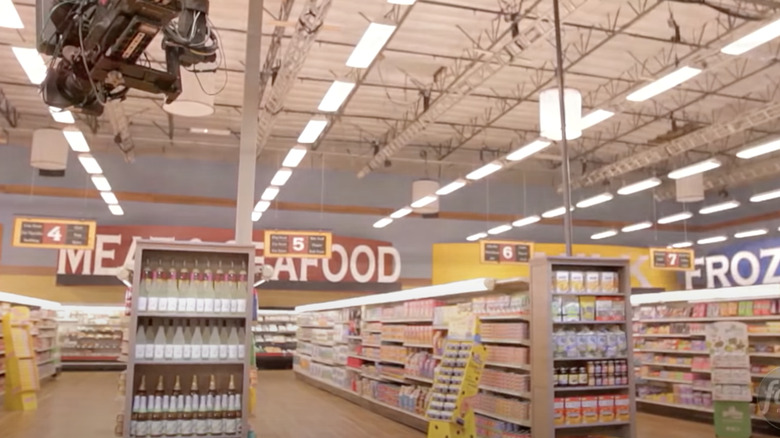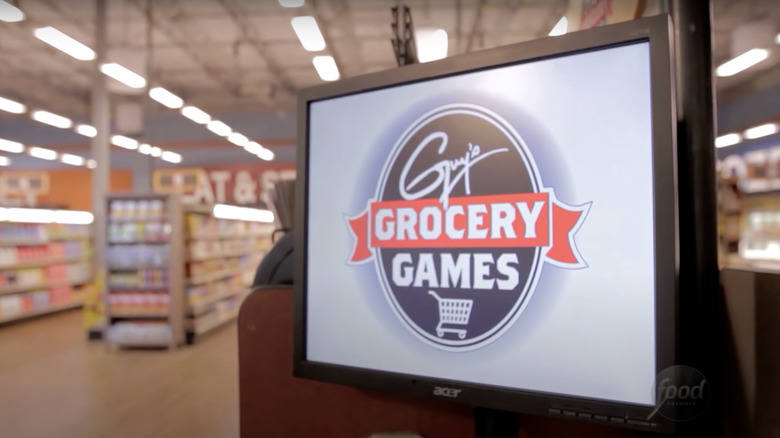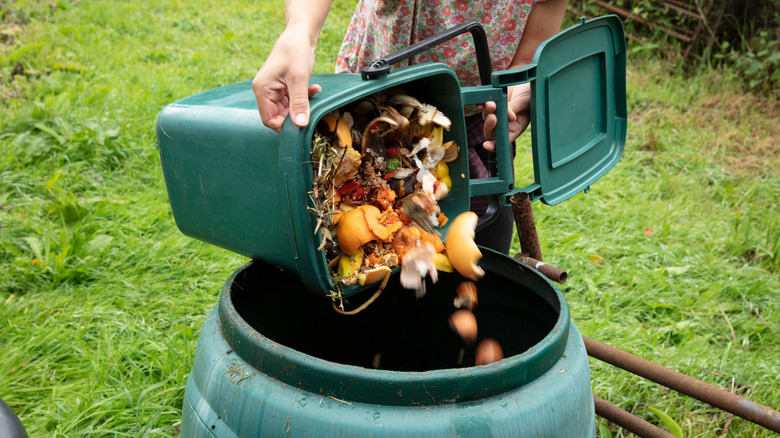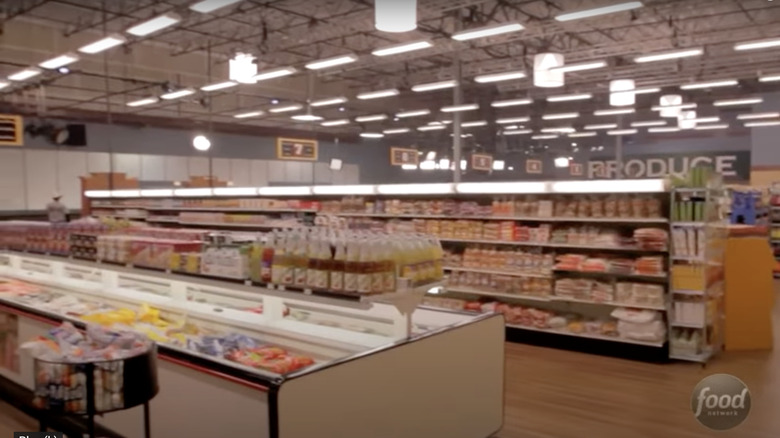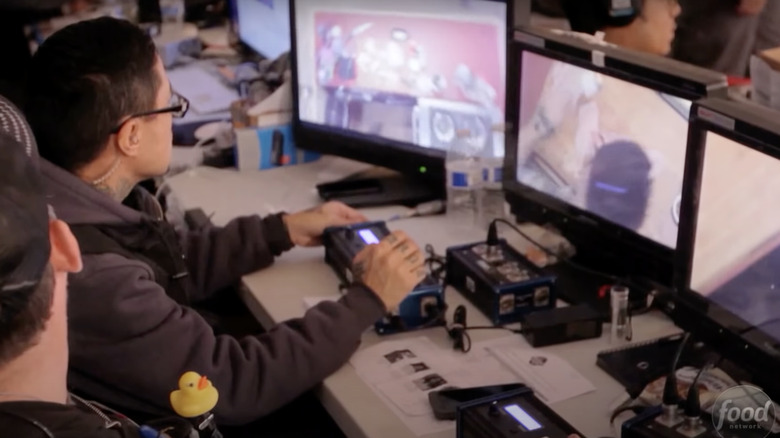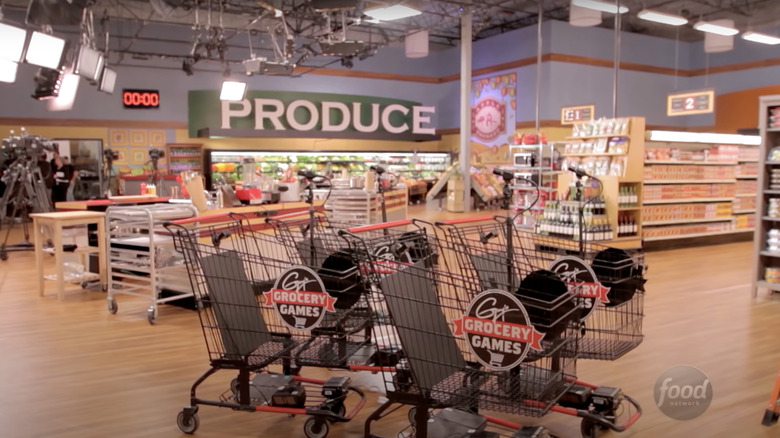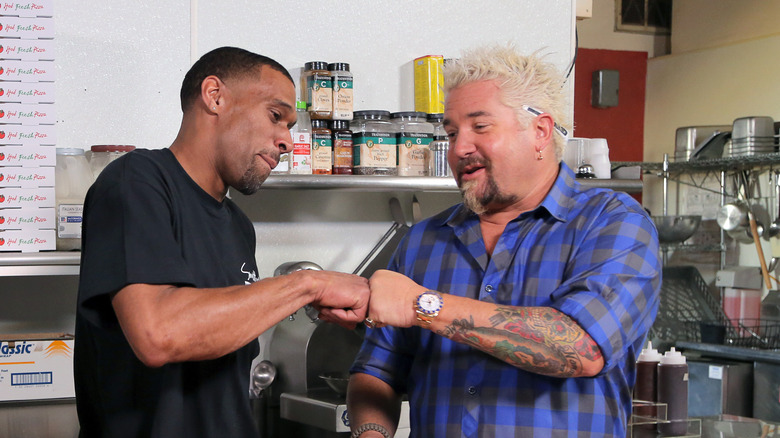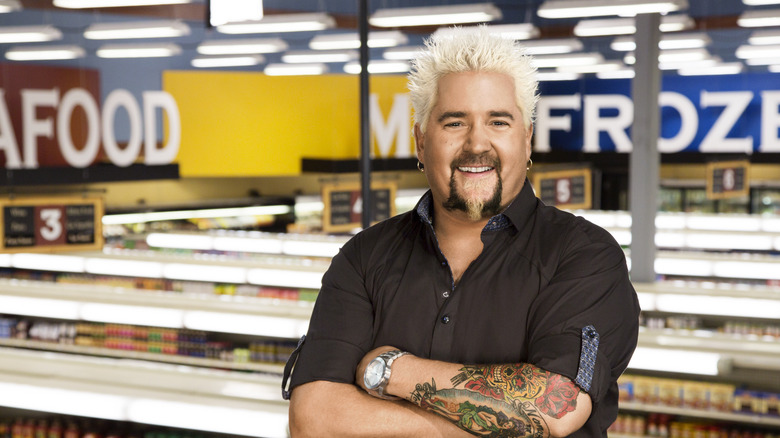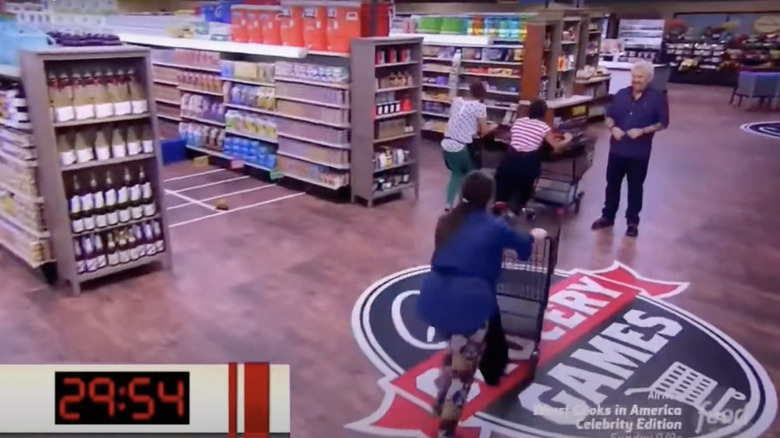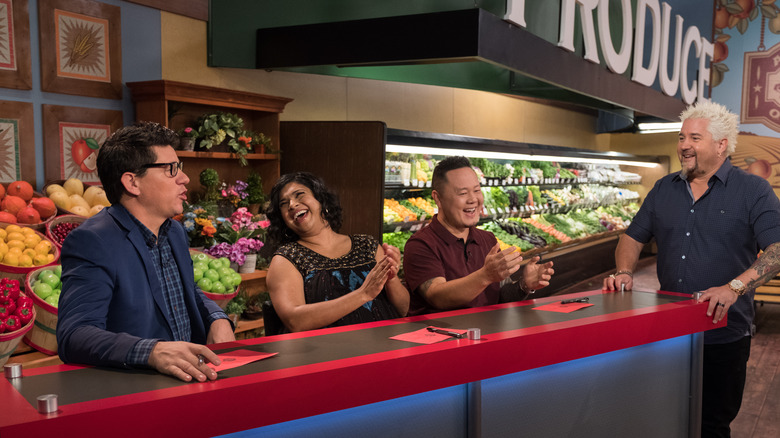What The Cameras Don't Show You On Guy's Grocery Games
"Guy's Grocery Games” is one of the most fast-paced, colorful, and twisting cooking shows on television today. The show's host Guy Fieri, also of hit show "Diners, Drive-ins and Dives," leads four contests through three surprise cooking challenges they must shop for and cook, all within the walls of Flavortown Market. It is a show that makes you feel like anything can happen — because anything can. Over the course of an episode, viewers watch contestants run through the aisles of Flavortown Market, facing unexpected challenges that force them to use every ounce of cooking creativity they have to serve the judges the best dish possible, all within a sixty-minute timeframe.
To make a show like this work as seamlessly as "Guy's Grocery Games" does is a feat that requires a lot to happen behind the scenes. From building a literal grocery store like the set seen on the television show to finding the best and most creative chefs to compete, we will guide you through what the cameras don't show you on "Guy's Grocery Games."
They built their own grocery store
If you've ever watched "Guy's Grocery Games" and thought to yourself, "That looks like a real grocery store," that's because functionally, it is. The first season of the show was filmed inside the grocery store, Fields Market, in the West Hills, Calif. After the first season ended, however, Flavortown Market moved to Santa Rosa, Calif., so host Fieri could be closer to his family and other business ventures. To start the process, they did what any sane production company would do: it leased a 15,500 square-foot building and built its own grocery store for the purpose of filming.
While most grocery stores take two years to complete construction, the aptly named Flavortown Market came up in just two weeks, per Food Network — and that's not due to cutting corners. In fact, not only does Flavortown market contain all the things a typical store would carry, but all of its aisles are wider to allow contestants to run through the shop more easily. The market features a fully stocked set of over 20,000 food items, as well as electricity and plumbing throughout the set — it is a fully functional grocery store. Sadly, it isn't open to the public, so if you want to shop at Flavortown Market, it's time to brush up on your cooking skills and apply to be on the show.
It's fully stocked
Not only is Flavortown Market built to be a functional market, but it is fully stocked to boot. Of the more than 20,000 items in Flavortown Market, there are 241 types of produce, more than 67 meat items from local meat provider Santa Rosa Meat & Poultry, and a full assortment of fresh and frozen foods, including deliveries of 442 pounds of fish per week, per Food Network. If you see a product on the shelf, it's an actual item, not a placeholder or a fake. The items even have their own barcodes for checkout.
Every aisle shown is real, including the equipment aisle, where contestants are able to grab more cooking gear if they need it. "Guy's Grocery Games" judge Brandi Milloy told PopSugar that the products team strives to provide all the products contestants could need, including rare and unique foods. She goes on to tell the source, "There is no such thing as a 'fake aisle' in Flavortown."
The only things you won't find in Flavortown Market, according to the set designer Scott Storey, are a pet food aisle and a baby aisle, per Reality Blurred. One would hope they wouldn't be needed for a cooking competition.
Flavortown Market uses 12 houses' worth of power
Running a fully functioning grocery store like Flavortown Market isn't easy. Between lights, refrigeration, freezers, and the sheer volume of a 15,500 square-foot warehouse-turned-grocery store, it takes a lot of power to keep Flavortown up and running, per Food Network. Specifically, it takes 2,400 amps worth, which is enough to power 12 houses.
Most of the electricity is used by the large cooling section. Remember, all that produce shown on TV is real, and "Guy's Grocery Games" went for authenticity when producers built a fully functioning market. This means they work hard to keep all the produce and perishables fresh for the contestants cooking. In addition to this, there are around 500 lights in the market that need to be powered, including lighting on the shelves to help contestants find products quickly. All of this results in a huge amount of energy usage, going above and beyond what other grocery store-based shows have done in the past.
There is no food waste
With all the food available in Flavortown Market, it seems unreasonable to expect contestants to cook and serve everything in the market during their time on the show. Happily, that is not the case, but then what do they do with all that food? There must be a lot of food waste, right? Not as much as you'd expect. The good people at "Guy's Grocery Games" go above and beyond to ensure that there is as little food waste as possible.
All of the fish and meats come vacuum sealed so that they last as long as possible, per Food Network. Fresh produce is delivered every week, and anything that is no longer usable gets composted — but that's not all. At the end of the week, all perishable items are checked, and anything that is nearing its expiration is donated to local food banks. Even the food scraps and leftovers are donated to farms to feed animals and livestock. Thanks to the efforts of the people behind "Guy's Grocery Games," truly nothing goes to waste, reducing its overall environmental impact.
Producers pay incredible attention to detail
It should come as no surprise that a show that puts in the effort to build its own grocery store and fully stock it would also pay incredible attention to little details.
While almost everything in the Flavortown market is real, there are a few props, per Food Network. The set designers of Flavortown Market include items, such as newspaper racks, that you wouldn't need in a game show supermarket, but really drive home the feeling of being in a real supermarket. There is even a check-writing platform on the checkout counter, even though no one shopping at Flavortown Market would need to write a check. Additionally, there's a store hours sign on the market's door.
When choosing items for the store, producers get products from local fish and meat providers and work hard to provide more than one option for different brands. They don't want the show to feel like it has large sponsors, so they try to include products that have cool labels or funny names.
The show requires numerous cameras
"Guy's Grocery Games" guest judge Mellisa d'Arabian said it all when she told Food Network, "You would not believe the number of cameras that are on set!" It's true — it takes a lot of cameras to film a single episode of "Guy's Grocery Games." On average, it requires up to 30 cameras to film an episode, to be exact. That's a lot of cameras, but they go to good use, per Food Network.
All of these cameras are needed so that nothing is missed. In a game where contestants are running through aisles in every direction and there are several moving pieces, it takes all of those cameras to ensure nothing is missed. There need to be cameras to focus on the judges, on Guy Fieri, and on each of the contestants as they cook and dash through the aisles. With so many shots, even full-size cameras can't capture all of the action. That's why they also include mini ones attached to the carts that contestants take while shopping in Flavortown Market.
It takes 12 hours to film one episode
Watching an episode of "Guy's Grocery Games" only takes 30 minutes, but filming an episode takes a lot longer. Former contestants have opened up about the long day of filming it takes to appear on an episode.
Contestant DeAnna Germano told Syracuse.com that their day started at 5:00 a.m. when they were picked up at their hotel and brought to the set. After they got into appropriate clothes and makeup, the competition started. Each of the competition's three rounds lasted 30 minutes, which included shopping, cooking, and serving to the judges. You might think that the contestants' work would be done once the competition ends, but they still had plenty of tasks to complete after competing. Contestant Shepose Cenami told Delish that even once you're done, you have to participate in the interviews that run during the segment, which can last two-to-three hours. Finally, the contestants are able to return to their hotels around 6:00 in the evening, wrapping up what many people might consider a daunting 13-hour day.
In the end, though, contestants felt the opportunity and experiences were worth the effort. Germano said she made lifelong friends filming the show.
Casting is done in multiple ways
Getting onto TV can be a goal for many people, especially chefs who want to promote their skills and advance their careers. Luckily for fans of "Guy's Grocery Games," there is more than one way to appear on the show.
Potential contestants can apply to be on the show by filling out an online form. While the 51-question form is long, former contestants report that the overall process isn't too bad. Firefighter AJ, who appeared on a special firefighter episode of the show, described the process as long but worth it. It included Skype interviews and video submissions before officially being chosen and flown to California for shooting.
Not everyone who is chosen for the show applies. Sometimes, talent scouts reach out to people they think would be good for the show, as was the case for chef Keith Clinton, per the Memphis Flyer. Clinton recounts how he received a phone call at the restaurant he worked at one day from a talent scout. They had seen his posts online and thought he would be a good fit for the show.
Guy Fieri takes care of the contestants
When it comes to "Guy's Grocery Games," Guy Fieri lives up to his reputation as a nice guy, according to those who have been around him on the show. Former contestants and show staff have described how Fieri takes care of the contestants and even helps them when he can.
Judge Brandi Malloy recounted to PopSugar how before each show, Fieri takes the time to talk with the judges about the contestants. He goes over the backstory for each of the upcoming chefs and takes the time to remind the judges that the contestants have left their families to be on the show. This reminds them that they are humans and this appearance is a risk for some of them.
Fieri also talks to the contestants before filming, reminding them they are there to have fun and show the world their skills, according to Delish. Fieri doesn't stop there — he has been known throughout the show to give hints to try and help contestants. He has also been known to lend a helping hand to chefs as they look to improve and enhance their performance. All of this comes from his own goal of wanting the chefs to do well and come away with a valuable experience.
1.5 episodes are filmed a day
Filming an episode of "Guy's Grocery Games" seems akin to running a marathon. In addition to the 12 hours contestants spend filming an episode, judges and crew put in long days by filming more than one episode a day, according to Food Network. Judges for "Guy's Grocery Games" are even supposed to change outfits and refresh part of the way through the day to keep up with the grueling filming schedule. By filming 1.5 episodes a day, they are able to film two seasons in a little over a month.
While this sounds like a lot and maybe even intimidating, reports are that it's still a pretty sweet gig. Melissa d'Arabian describes it as being "like going to summer camp" — exhausting, but a lot of fun. Plus, gift baskets and yummy treats are provided, according to PopSugar. This is all, of course, in addition to the nine meals a day being served to the judges during the filming of the show. One thing is for sure: you will never go hungry during the long days on the set of "Guy's Grocery Games."
There is no way to prepare
"Guy's Grocery Games" is known for its face-paced structure and games that keep you guessing. Guy Fieri has been known to keep guests on their toes by getting tricky during countdowns, and waiting until after food has been collected to reveal the true challenge. All of this leads to a chaotic game that requires ingenuity and adaptability, and unfortunately, there is no way for contestants to prepare for it.
Contestants don't know what the challenges will be until they get there. Former contestants Keith Clinton and Nicholas Moulton both suggest there is no way to prepare for the show because you simply don't know what's going to happen. This is in contrast to other shows, which allow contestants to bring recipes ahead of time, according to Insider. Given the nature of the show, where contestants don't always know what ingredients will be available to them, preparation simply isn't possible. Contestants are forced to think on their feet, making for a challenging yet exhilarating experience.
Contestants have to enter through aisle six
For a show that relies heavily on authenticity and the real shock and surprise on contestants' faces, there are still elements of the show that are highly staged. This is partly to make sure they are getting all the filming they need.
In "Guy's Grocery Games," the initial shot requires all contestants to enter Flavortown Market through aisle six. It doesn't matter where they need to go — this has to be the first stop. That is because a camera is stationed to get a shot of all the contestants running together at the start. It provides a pivotal shot for the opening of the challenge. Sometimes, however, this means that contestants are forced to double back to the aisle they actually want to go to.
With all of that running around, it's a good thing Flavortown Market is chock full of food. Someone could get hungry making all of those mad dashes.
Elimination is agonizing for the judges
Getting eliminated from anything is agonizing. No one ever wants to put themselves out on a limb, only to get hurt. That is why it is comforting to know that on "Guy's Grocery Games," the decision on who goes home is just as agonizing for the judges as it is for those going home.
While many of us feel like we know who will go home from watching the rounds, former judges say that during filming, this simply isn't true, according to Food Network. The decision on who is going home isn't made beforehand, and isn't made lightly — the judges never know who is going home during the cooking rounds. A decision isn't made until after they debate — sometimes heatedly — about who deserves to stay and who has to go home. The judges know that their decisions impact real people, which is something Fieri makes sure they remember, according to PopSugar. While someone has to go home, they always take the time to think fully about the decision and try to be as respectful as possible during the announcement.
